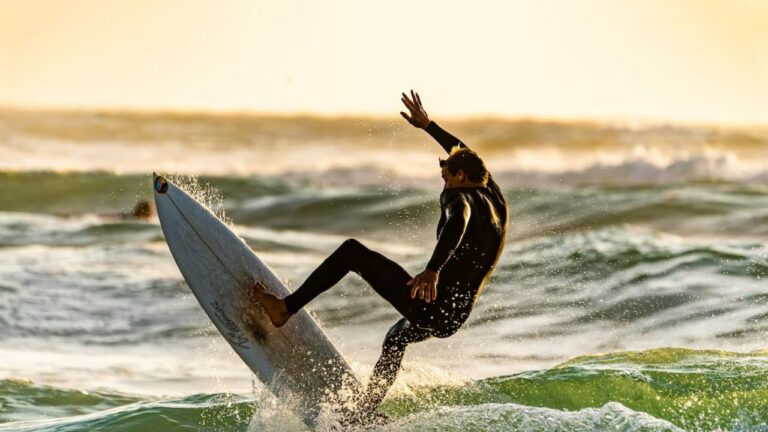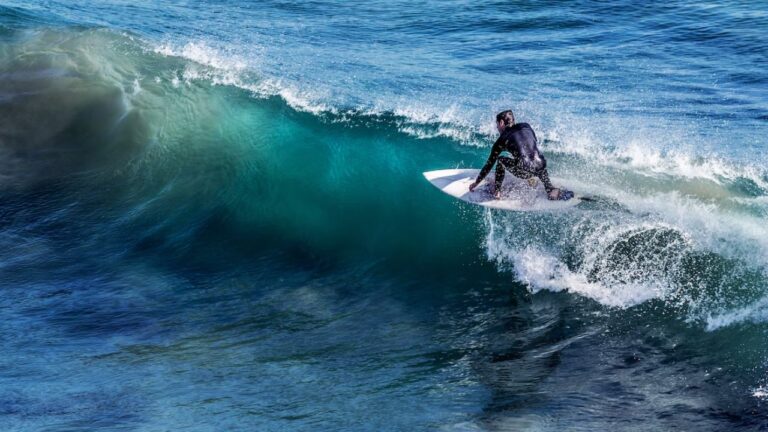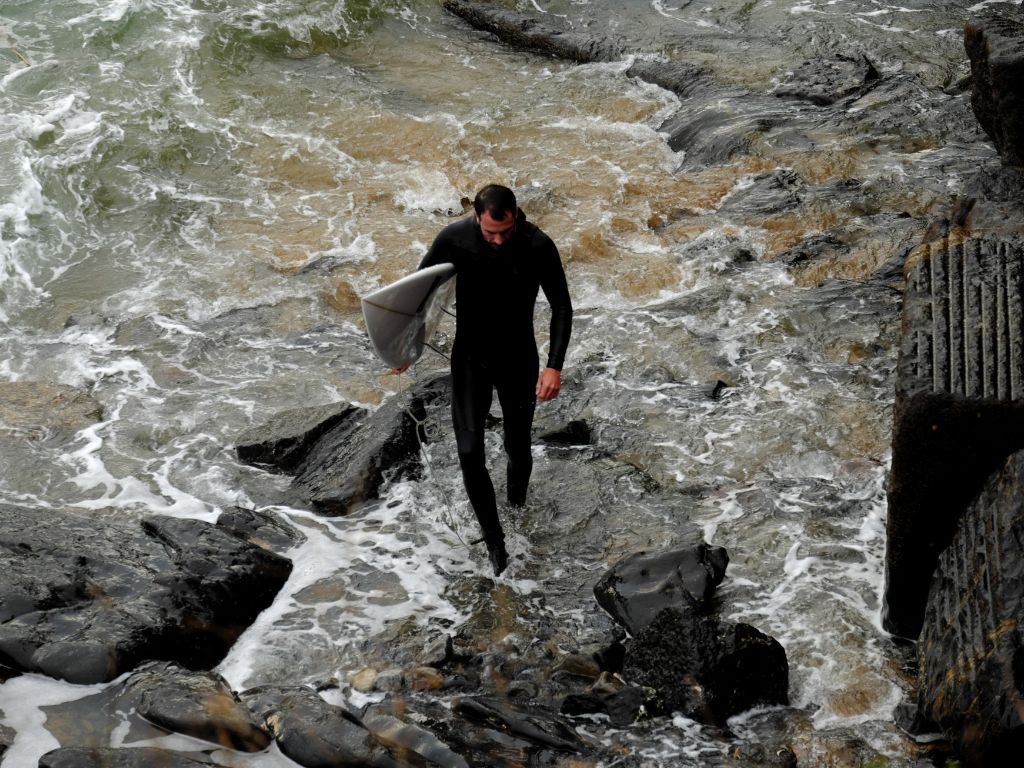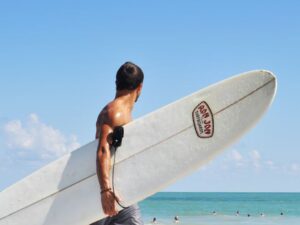When you think of surfing, you might imagine the sun, the sand, and the thrill of riding a wave. But it’s not that easy – surfing is an intense outdoor sport for a good reason. Although, that’s a good thing because surfing is an effective way of shredding calories.
I know, I know. It’s hard to relate one to the other. After all, surfers do get pigeonholed into one category – hot, ripped, blonde guys. But the truth is that most of us can learn to surf with some basic physical fitness and lots of practice.
Surfing can help you lose weight and get in shape. Unfortunately, I can’t make any promises about becoming blonde through it. But I have a separate article on “Why do most surfers have blonde hair?“
Back to the main topic, how exactly does surfing help you lose weight? And what can you do to facilitate the whole process? Let’s find out.
Does surfing help you reduce belly fat?
Generally, surfing can help you reduce belly fat and get in shape, provided you pair it with a well-designed diet and exercise plan to align with your fitness goals. If done right, you can get ripped and develop abs through surfing.
When out on the water, you use your muscles to paddle, maintain balance on the board, and ride waves. All that physical activity adds up and burns more calories than you can imagine.
1. Surfing has a high-calorie burn potential.
As I just mentioned, surfing requires significant energy. This energy expenditure can result in a significant calorie burn, which benefits weight loss.
According to some estimates, an hour of moderate surfing can burn up to 200-600 calories for an average surfer. This is roughly the same amount you would burn during a vigorous cycling or running session.
One study published in the Journal of Strength and Conditioning Research found that surfers had significantly lower body fat percentages and higher lean body mass percentages than non-surfers, indicating that surfing can have a significant impact on body composition.
Note: As with any exercise, the number of calories you burn will depend on your body weight, how hard you’re working, and the intensity of your session.
Here’s an approximate breakdown of the amount of calories you would burn per hour of the following activities:
| Activity | Pace/Speed | Intensity | Calories Burned (per hour) – Men | Calories Burned (per hour) – Women |
| Surfing | N/A | Moderate-High | 400-500 | 300-400 |
| Walking | 3 mph | Low | 240-300 | 200-250 |
| Brisk Walking | 4 mph | Moderate | 360-460 | 300-380 |
| Jogging | 5 mph | High | 720-890 | 580-710 |
| Running | 8 mph | Very High | 1300-1600 | 1050-1300 |
| Biking | 12-14 mph | High | 480-600 | 400-500 |
| Swimming | Freestyle, fast pace | High | 720-890 | 580-710 |
2. Surfing is a type of resistance training.
In addition to burning calories, surfing can also help tone your muscles.
Surfing is a great resistance training method. The repetitive motions of paddling and pop-ups help work your core, arms, legs, and back. The resistance of the water also adds an extra layer of challenge to your workout, helping to build strength and endurance.

3. Surfing improves your cardiovascular health.
For the reasons mentioned above, surfing is a godsend for your heart. It helps to improve your overall cardiovascular endurance. The physical demands of this sport increase heart rate, which in turn can help improve the health of the heart and lungs.
4. Surfing is good for your mental fitness too.
That might feel like one praise too many to some of you. But I swear it’s true. One of the most underrated benefits of surfing is its ability to help improve your mental health.
Surfing can help reduce stress, anxiety, and depression. Studies show that being in the ocean, the sensation of being around the waves can trigger the release of endorphins, the hormone responsible for our well-being.
Surfing can do more than just shred calories. It can also help you build some serious muscle! As mentioned earlier, surfing is a full-body workout that engages multiple muscle groups.
How does surfing change your body?
One of the primary ways surfing helps build muscle is through the various movements involved in the sport.
1. Upper Body & Core
Paddling, in particular, is an excellent workout for your upper body and core, as it requires a lot of arm and back strength to power through the water.
This constant resistance builds muscle mass over time, resulting in a more defined and toned upper body.
2. Lower Body & Core
On the flip side, popping up onto the board and balancing requires great leg and core strength. As you pop up, you use your legs to push yourself into a standing position, engaging your quads, hamstrings, and glutes.
Maintaining your balance on the board requires core strength, as you need to stabilize your body and adjust your weight as the board moves beneath you.
Over time, consistent surfing can improve muscle mass and definition in these areas, resulting in a more sculpted lower body.
3. General Muscle Toning
Surfing can also be a great way to work on specific muscle groups. For example, surfers often focus on building their shoulders and back muscles to help with paddling and maintaining proper posture on the board.
Some famous surfers are known for their impressive physiques, which is a testament to the physical demands of the sport. Professional surfer Kelly Slater, for example, is renowned for his muscular and toned physique.
In addition to being a legendary surfer, Slater is an avid fitness enthusiast and has been known to incorporate yoga, Pilates, and other workouts into his training routine.
Here’s a detailed article on the effects of surfing on your body:
How to safely maximize weight loss through surfing?

Surfing is a fun and thrilling activity that offers numerous health benefits. However, like any sport, it comes with certain risks and precautions that must be considered.
1. Always learn proper techniques and posture first.
As with any sport, proper technique is important to help prevent injuries and maximize the benefits of the workout. This is especially true with surfing.
Improper technique can increase the risk of injuries such as sprains, strains, and drowning. Before attempting to surf, you must learn the proper techniques from an experienced instructor.
2. You can’t avoid 100% of the injuries. Reduce the risk instead.
Surfing can be physically demanding, and there will always be risks involved.
To reduce the risk of injury, it’s important to warm up properly, use proper technique, and stay in shape by incorporating other forms of exercise into your routine.
3. Use proper gear and keep it maintained.
You don’t necessarily need to buy the most expensive gear but must use the right one.
Proper gear is essential for staying safe and comfortable in the water. A wetsuit, booties, and a leash are all important pieces of gear to keep you warm and connected to your board.
Additionally, post-ride care is important. Ensure your gear is well-maintained and ready for the next bout.
4. Talk with a doctor or a professional for clearance.
I can’t quantify how many downplay this crucial and fairly simple step. You must consult a doctor or a professional before starting any new exercise routine, especially if you have any health conditions.
5. Be mindful of your environment.
Injuries such as sprains, strains, and fractures can also occur from falls or collisions with other surfers or objects in the water. You must know your surroundings and other surfers, especially in crowded waters.
You must also consider somewhat arbitrary factors such as sudden strong currents, waves, and marine life.
Be mindful of marine life in the water, such as sharks or jellyfish. And avoid surfing in hazardous conditions or known habitats.
6. Remember to eat and drink properly.
Any nutritionist worth their salt will tell you you need calories to burn calories. More specifically, you need the energy to burn calories, but it sounds better.
Stay hydrated and fuel your body with the right nutrients for optimal performance and recovery. Surfing is a high-intensity workout, so eating a well-balanced diet rich in lean protein, healthy fats, and complex carbs is essential.
Drinking plenty of water and electrolyte-rich fluids (like coconut water) will also help prevent dehydration and cramping.
For me, I have been using Liquid I.V. Store’s Hydration Multiplier for a couple years now. You can use the same should you need a quick electrolyte-rich hydration solution. You can buy it on Amazon.
What is the diet of a surfer?

We’ve already established that surfing is a highly demanding physical activity requiring energy and endurance. So, pay attention to your nutrition and hydration.
Protein is especially important for surfers as it helps repair and build muscle tissue – which is essential for improved performance and muscle building. Good protein sources include lean meats, fish, eggs, dairy, legumes, and nuts.
Complex carbohydrates provide sustained energy for prolonged physical activity. These include whole grains, fruits, vegetables, and legumes.
In addition, healthy fats such as those found in avocados, nuts, seeds, and fatty fish are also essential for providing sustained energy and supporting overall health.
Another important aspect of nutrition for surfers is staying hydrated. Surfing can be a very dehydrating activity, especially when done in warm or sunny conditions.
It’s important to drink plenty of water before, during, and after your surfing sessions to prevent dehydration and improve performance. Additionally, consuming sports drinks or coconut water can help to replenish electrolytes lost through sweating.
In addition to a healthy diet and proper hydration, some specific foods and drinks can be especially beneficial for surfers looking to lose weight and build muscle.
One example is the acai bowl, which has become a popular pre- or post-surf meal among surfers. Acai berries are rich in antioxidants, fiber, and healthy fats, making them ideal for improving energy and aiding recovery.
Other surfer-friendly foods include bananas, which are rich in potassium and can help prevent muscle cramps.
You can try quinoa – a high-protein grain that can provide sustained energy and aid in muscle building. And smoothies made with protein powder, fruits, and vegetables provide a quick and convenient source of nutrients and energy.
Expert QnA
Q. Is surfing better than the gym?
Surfing may or may not be better than gym based on your individual needs and fitness goals. Surfing is a full-body workout that burns many calories, improves cardiovascular health, and tones muscles. However, it’s not a substitute to exercise as the latter is necessary too.
In comparison, the gym offers a wider range of exercises and equipment that can target specific muscle groups and allow for more flexibility in scheduling and location. Ultimately, the best fitness routine is one that you enjoy and can stick to consistently.
Q. Can you get six-pack abs from surfing?
While surfing can certainly contribute to an overall active and healthy lifestyle, it may not be enough to achieve a six-pack. Achieving six-pack abs typically requires a combination of regular exercise, a healthy diet, and low body fat levels.
Q. Is surfing a HIIT workout?
Technically, surfing can be considered a HIIT (High-Intensity Interval Training) workout as it involves short bursts of intense activity followed by periods of rest or lower intensity. However, the intensity of the workout can vary depending on wave conditions and your skill level.
Q. How many times a week should I surf?
As a beginner, you should start surfing for no more than 1-2 times a week. It’s important to first build stamina and avoid injury. More experienced surfers can aim for 3-5 times a week to improve their skills and maintain their fitness level. The frequency should be balanced with proper rest and recovery.





